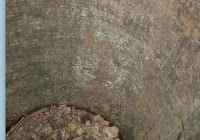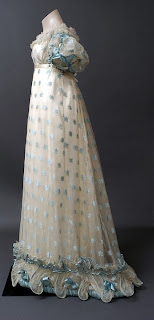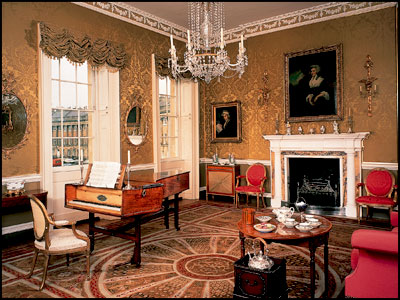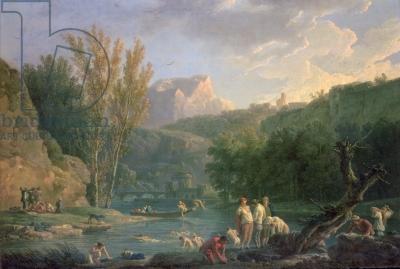I am engaged in domestic matters, with a kitchen remodel, and I have some valuable advice for you all:
1. Do not wait 15 years to clean your vinyl blind.
2. If you do, do not clean them outside when there’s a heat index of 105.
3. If you want to have a truly depressing aesthetic experience, shop for light fixtures and dining chair pads.
On a more cheerful note, since it’s so hot here–and I was one of the lucky ones, I got my power back after only 36 hours, and while it was off had a long trip to Ikea and went to a performance of Mahler 3, as well as enjoyable clothing-optional-with-a-book moments at home–let’s all scream for ice cream and cooling summer drinks. This is an amended post recycled from a few years ago about the joys (for the rich) of Regency summer living:
 Ice cream certainly wasn’t invented in the Regency, but it was very popular among those who could afford it–visit historicfood.com to check out recipes for this gorgeous collection of ice creams and water ices: in the back, royal cream ice, chocolate cream ice, burnt filbert cream ice and parmesan cream ice; in front, bergamot water ice and punch water ice. I’m guessing that the parmesan cream ice (and some of the others, too) must have been served as a savory accompaniment, to be expected when each remove would include items that nowadays we’d consider being strictly dessert.
Ice cream certainly wasn’t invented in the Regency, but it was very popular among those who could afford it–visit historicfood.com to check out recipes for this gorgeous collection of ice creams and water ices: in the back, royal cream ice, chocolate cream ice, burnt filbert cream ice and parmesan cream ice; in front, bergamot water ice and punch water ice. I’m guessing that the parmesan cream ice (and some of the others, too) must have been served as a savory accompaniment, to be expected when each remove would include items that nowadays we’d consider being strictly dessert.
 Were ice cream cones used in the Regency? According to this illustration from 1807, and article at historicfood.com, they were.
Were ice cream cones used in the Regency? According to this illustration from 1807, and article at historicfood.com, they were.
 The great houses made sure they would have plenty of ice by constructing an ice house–this is the interior of a brick-built Georgian ice house at Parlington Hall, Yorkshire, which measures a mighty 16 ft. in diameter and around 20 ft. deep.
The great houses made sure they would have plenty of ice by constructing an ice house–this is the interior of a brick-built Georgian ice house at Parlington Hall, Yorkshire, which measures a mighty 16 ft. in diameter and around 20 ft. deep.
 Ice would be cut from local lakes or imported from countries such as Norway, and insulated with straw. The actual igloo-like design of the ice house, and its position in a shady spot on the grounds would aid in keeping the ice cool.
Ice would be cut from local lakes or imported from countries such as Norway, and insulated with straw. The actual igloo-like design of the ice house, and its position in a shady spot on the grounds would aid in keeping the ice cool.
As for cool drinks, spruce beer was always a favorite. Made from spruce buds, its flavor could cover a whole range from citrus to pine–or possibly not. A reviewer I found the first time around bravely tested a modern brand and came to this conclusion:
If ever offered a bottle, save yourself the trouble and drink some paint thinner. It will taste the same, but you can wash your brushes with the remaining thinner you don’t drink. Spruce Beer would probably melt the bristles off. But it’s not all bad …there is a sweet buffer that does keep you from projectile vomiting.
 Lemon barley water was a favorite, too, first manufactured by Robinson and Belville in 1823 in powder form, to be mixed with water to cure kidney complaints and fevers. It also aids in lactation, should you have the need, and Robinson’s lemon barley water is still the official drink of Wimbledon for players (although presumably not for that reason). Here’s a modern recipe from cuisine.com.
Lemon barley water was a favorite, too, first manufactured by Robinson and Belville in 1823 in powder form, to be mixed with water to cure kidney complaints and fevers. It also aids in lactation, should you have the need, and Robinson’s lemon barley water is still the official drink of Wimbledon for players (although presumably not for that reason). Here’s a modern recipe from cuisine.com.
As for lemonade itself, here is a recipe from the seventeenth century from coquinaria.nl, and an experiment using Mrs. Beetons’ at vintagecookbooktrials.
I also looked around for some ginger beer recipes–ginger was readily available as it was a subsidiary crop in the sugar-producing islands and found this one at allrecipes.com which claims to date back to the Tudor era. One thing I love about it is that although the preparation time is relatively quick, the recipe is ready in 14 days and 30 minutes. Don’t forget those crucial 30 minutes!
What are your favorite summer drinks or ice cream flavors and do you make any yourself? I love historical food sites almost as much as ice cream and lemonade. Do you have any to recommend?












